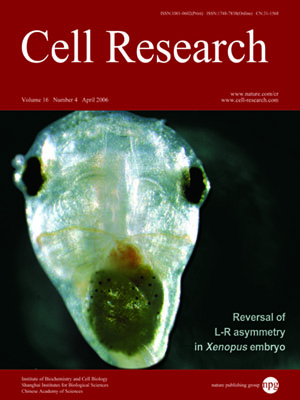
Volume 16, No 4, Apr 2006
ISSN: 1001-0602
EISSN: 1748-7838 2018
impact factor 17.848*
(Clarivate Analytics, 2019)
Volume 16 Issue 4, April 2006: 367-376
ORIGINAL ARTICLES
Microfilament-binding properties of N-terminal extension of the isoform of smooth muscle long myosin light chain kinase
Chun Xiang Yang, Hua Qun Chen, Chen Chen, Wei Ping Yu, Wen Cheng Zhang, Ya Jin Peng, Wei Qi He, Dong Mei Wei, Xiang Gao, Min Sheng Zhu
Model Animal Research Center and National Key Lab of Medicine, Nanjing University, Nanjing 210061, China ; College of Life Science, Nanjing Normal University, Nanjing 210097, China;
Medical College, Southeast University, Nanjing 210096, China; 4Huadong Research Institute for Medical Biotechnics, Nanjing 210002, China
Correspondence: Min Sheng Zhu(zms@nicemice.cn)
Myosin light chain kinases (MLCK) phosphorylate the regulatory light chain of myosin II in thick filaments and bind to F-actin-containing thin filaments with high affinity. The ability of short myosin light chain kinase (S-MLCK) to bind F-actin is structurally attributed to the DFRXXL regions in its N-terminus. The long myosin light chain kinase (L-MLCK) has two additional DFRXXL motifs and six Ig-like modules in its N-terminal extension. The six Ig-like modules are capable of binding to stress fibers independently. Our results from the imaging analysis demonstrated that the first two intact Ig-like modules (2Ig) in N-terminal extension of L-MLCK is the minimal binding module required for microfilament binding. Binding assay confirmed that F-actin was able to bind 2Ig. Stoichiometries of 2Ig peptide were similar for myofilament or pure F-actin. The binding affinities were slightly lower than 5DFRXXL peptide as reported previously. Similar to DFRXXL peptides, the 2Ig peptide also caused efficient F-actin bundle formation in vitro. In the living cell, over-expression of 2Ig fragment increased 搒pike�-like protrusion formation with over-bundled F-actin. Our results suggest that L-MLCK may act as a potent F-actin bundling protein via its DFRXXL region and the 2Ig region, implying that L-MLCK plays a role in cytoskeleton organization.
Cell Research (2006) 16:367-376. doi:10.1038/sj.cr.7310047; published online 13 April 2006
FULL TEXT | PDF
Browse 1962


